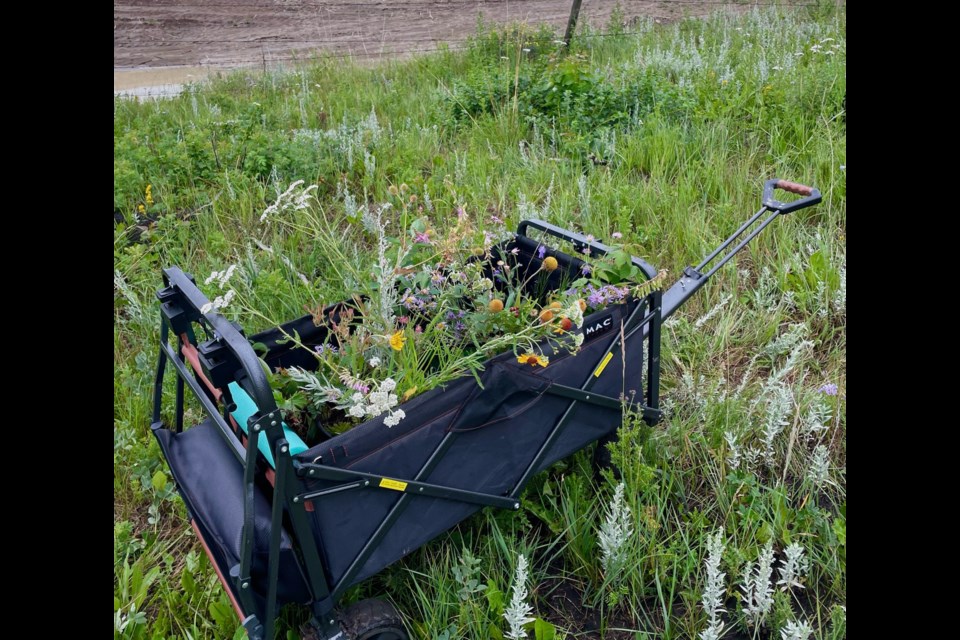A Cochrane based organization is working in cooperation with local developers to rescue as many native plants and shrubs as possible from the community's developable greenspaces before the bulldozers dig in.
Before the start of every rescue, Blake McNeill sends someone to assess the potential work load. That assessor reports back to McNeill, who sends the call out to volunteers eager to put in the work. A game plan is devised and entire weekends are scheduled out. Then they get to work rescuing as many plants as possible.
McNeill is the co-founder of the Alberta Native Plant Rescue Foundation, a largely volunteer-driven organization that has become the first call for many developers looking to begin a project on an uncultivated piece of land. For the last year the Foundation has been working to save native plants from development sites in Cochrane, and their efforts at one development site owned by Calbridge Homes recently wrapped up on July 19.
Native plants require almost no upkeep and are hardy enough to survive without human assistance. They’re the favourites of greenspace developers looking to build a park without having to worry about the required workload of keeping plants alive, or of homeowners who want the same.
Construction companies and land developers have recently been calling on the Foundation to rescue native plants from development zones so they can be transplanted in greenspaces of private homes. Calbridge made the call to McNeill to rescue the native plants at the company’s The Summit Lands development site in south Cochrane after the Foundation rescued thousands of plants along the Highway 1A and 22 interchange a couple of years ago.
“The idea of a rescue is quite foreign to developers,” McNeill said. “It’s outside of what they typically do…but the developers trust us to do the rescues.” McNeill heaps praise upon Calbridge, saying they’ve been “outstanding to deal with.”
“Calbridge has been very supportive,” he said. “[They care about] how we make better use of native materials from a development process.” Admittedly, McNeill said he doesn’t much understand the construction industry, and that even he, who, as a plant lover and urban beekeeper, learned from Calbridge.
The development company taught McNeill about tree transplanting, which they then did to create two brand new aspen groves in Cochrane from trees moved out of the Summit site. In return, the Foundation acts as a bridge for development companies to save plants that they have no experience in saving, while also preparing the soil for development.
McNeill was a mechanical engineer who worked in computer science and for several start-ups before he transitioned into his work with the Foundation. As of today the Foundation employs the services of over 500 volunteers and has rescued over 20,000 native plants this year alone.
Their rescues have helped the Friends of Fish Creek Provincial Park in Calgary to populate the park with countless species of native plants. Groups like the Friends of Fish Creek and even individual home owners choose native plants to populate their greenspaces because it helps to drastically reduce water usage, a reason that McNeill says municipalities should also be using to transition its greenspaces to native plant areas.
“It’s actually a pretty good reason to change over to native plants,” he said. “You’re spending an awful lot of money on plants…that really don’t belong where they are. Native plants would significantly reduce costs and maintenance over time.”
On the other hand, McNeill understands that the work to build up an ecosystem of native plants is hard and takes a good deal of time, but he has seen firsthand that there is a passion in people–especially the hundreds of volunteers who help to rescue native plants–to bring them back to the native environments.
With time and experience comes an expanded knowledge base that has added to the growing reputation of the Foundation as a premier native plant rescuer and friend of development companies. McNeill said they’ve recently signed on with Quilico to assess its development sites and rescue native plants, adding that company to a roster that already features the developer Genesis.
But with all the work they do and all the places they do it in, McNeill said Cochrane still has some of the best territory to rescue native plants in. The grasslands surrounding Cochrane, although not pristine native grasslands, have made for a good work environment for the Foundation.
Development, which is frequent in Cochrane, is actually not the greatest threat to native plants, McNeill said. It’s cultivation agriculture.
“Agriculture built Alberta, and we really like to eat … so there really is no right answer [on how to protect native plants]. We’re just trying to focus on making better choices.”
McNeill’s group is aware of the contradictions inherent in working with construction developers to rescue native plants from construction development. But the work needs to be done, and they are there to do it.
“We all live in houses and nobody in our group is going to say we shouldn’t build houses, that doesn’t make a lot of sense,” McNeill said. “So, instead what we’re trying to do is make the development process better.”




